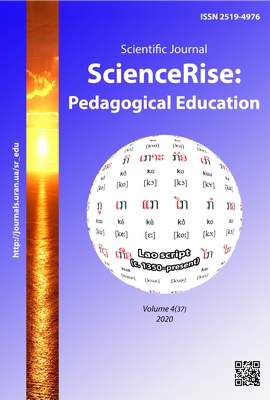Development of art education in the Yelisavetgrad region (second half of XIX - beginning of XX century). According to the dictionary of «Artists of steppe Ukraine»
DOI:
https://doi.org/10.15587/2519-4984.2020.204819Keywords:
dictionary "Artists of Steppe Ukraine" pedagogical education, pedagogical biography, art, art and industrial education, educational institutions, Evening drawing and design classes, YelisavetgradAbstract
The article considered the development of art education in the Yelisavetgrad region (second half of XIX - early XX century) through the prism of biographies of artists, presented in the publication "Artists of Steppe Ukraine", The main center of art education at that time in Yelisavetgrad were Evening drawing and design classes, which were founded by P. Krestonostsev. In the dictionary on a wide source base more than 200 articles about artists and their students were collected and unified, that were once in the steppe region (Yelisavetgrad region at that time was part of the Kherson province, now - the territory of the Kirovograd region with the regional center of Kropyvnytskyi). Accentuated, that artistic life at the time developed in a pan-European context. Many artists, presented in the dictionary, made a significant contribution to the art not only of Ukraine but also of other countries. The article also revealed features of the work on the dictionary: installation of little known names - artists-teachers and their students, clarification of biographies of already known personalities. Research biographies made it possible to outline starting points and ways of future searches for the purpose of historical and pedagogical reconstruction of a condition and dynamics of the cultural and educational process in the region, birth and existence of a local art school and the development of the art process as a whole. Exactly the research will contribute to the generalization of artistic pedagogical experience and popularization of creative use of ideas of outstanding teachers in modern conditions, will play an important role in ensuring the development of research in modern pedagogical science, education and practice
References
- Bosa, I. O. (2013). Myttsi stepovoi Ukrainy (kintsia XIX – pochatku XX stolittia). Kyiv: IMFE im. M.T.Rylskoho NAN Ukrainy, 133.
- Vysikailo, T. V. (2017). Formuvannia fakhovoi kompetentnosti maibutnikh uchyteliv obrazotvorchoho mystetstva u protsesi plenernoi praktyky. Poltava, 243.
- Hurich, Z. V. (2017). Rozvytok khudozhnoi osvity v pochatkovykh ta serednikh navchalnykh zakladakh Khersonskoi hubernii (druha polovyna XIX – pochatok XX st.). Kyiv, 21.
- Panok, T. V. (2017). Teoretychni i metodychni zasady pidhotovky maibutnikh khudozhnykiv-pedahohiv u konteksti rozvytku vyshchoi khudozhnoi osvity Ukrainy (1917–1991 rr.). Kyiv, 40.
- Rusakova, L. I. (2017). Rozvytok pryvatnoi khudozhnoi osvity v Ukraini (druha polovyna XIX – pochatok XX stolittia). Kropyvnytskyi, 20.
- Filonenko, O. V. (2017). Osvita Kirovohradshchyny (Yelysavethradshchyny) v naukovykh refleksiiakh ukrainskykh uchenykh (druha polovyna XIX – XX stolittia). Kharkiv: Machulyn, 412.
- Shmahalo, R. T. (2005). Mystetska osvita v Ukraini ser. XIX – ser. XX stolittia: strukturuvannia, metodolohiia, khudozhni pozytsii. Lviv, 528.
- Bosko, V. (2004). Vyznachni postati stepovoi Ellady. Kirovohrad: Inf. merezha, 376.
- Obrazotvorche mystetstvo (mynule i suchasne) (2008). Kirovohrad, 312.
- Kolianchuk, O. (2005). Pavlo Zaporizhskyi – artyst- maliar z Velykoi Ukrainy ta yoho pravoslavni spivvitchyznyky. Tserkovnyi Kalendar, 217–225.
- Prischepova, V. A. (2011). K 150-letiiu so dnia rozhdeniia S. M. Dudina – khudozhnika, etnografa (po materialam MAE RAN). Antropologicheskii forum, 15, 608–649.
- Nekrasova, A. N. (2015). I. S. Zolotarevskii i khudozhestvenno-reprodukcionnaia masterskaia Glavnauki. Voprosy muzeologii, 1 (11), 12–20.
- Searching for boris major. Available at: https://sites.google.com/site/borismajorartist/home Last accessed: 9.07.2020
- Hendzel-Andreew, A. (2000). W „Dzienniku” Ferdynanda Ruszczyca o Ludomirze Sleńdzińskim. Ananke, 2-3, 24–25.
- Murielle Lucie Clément (Hrsg.). Raffaele Zanotti: Le Son de l'Est de Michel Matveev (2008). Écrivains Franco-russes. Amsterdam, 59–68.
- Meidler-Waks Sigalit (2019). Issachar Ber Ryback. Leipzig: Hentrich & Hentrich, 369.
- Zholtovskyi, P. M. (1983). Khudozhnie zhyttia na Ukraini v XVI – XVIII stolittiakh. Kyiv, 120.
- Sistematicheskii svod postanovlenii Elisavetgradskogo Uezdnogo Zemskogo Sobraniia 1888–1895 gg. (1895). Elisavetgrad, 897.
- Vedomosty uspevaemosty uchashchykhsia (1887). F. 60. Op. 1. Spr. 65. 222 ark. Derzhavnyi arkhiv Kirovohradskoi oblasti.
- Barkovskaia, O. M. (2010). Zhitie Georgiia Bostrema. Deribasovskaia – Rishelevskaia, 40, 263–280.
- Kyrychenko, O. (2009). Stylovi poshuky arkhitektora Oleksandra Lishnevskoho v yelysavethradskyi period tvorchosti (1895–1901 roky). Ukrainske mystetstvoznavstvo. Materialy, doslidzhennia, retsenzii, 9, 218–223.
- Nadiezhdin, A. (2004). Yakiv Pauchenko – arkhitektor Yelysavethrada. Materialy oblasnoi kraieznavchoi konferentsii: Kulturno-osvitni protsesy kraiu u XIX. Kirovohrad, 95–102.
- Sokol, K. G. (2006). Monumentalnye pamiatniki Rossiiskoi imperii. Moscow: Vagrius Plius, 432.
- Vedomosty uspevaemosty uchashchykhsia (1887). F. 60. Op. 1. Spr. 65. 222 ark. Derzhavnyi arkhiv Kirovohradskoi oblasti.
- Ot komiteta po ustroistvu khudozhestvennoi vystavki v Elisavetgrade (1913). Golos Iuga, 4.
- Bertrand, O. (2015). Ivan Pokhitonov (1850–1932). Catalogue Raisonné. Vol. 1. Luxembourg: Belart International Editions, 155.
- Wenger Steps from Films to Watercolor (1935). Art Digest, 10, 6.
Downloads
Published
How to Cite
Issue
Section
License
Copyright (c) 2020 Iryna Bosa Huleikova

This work is licensed under a Creative Commons Attribution 4.0 International License.
Our journal abides by the Creative Commons CC BY copyright rights and permissions for open access journals.
Authors, who are published in this journal, agree to the following conditions:
1. The authors reserve the right to authorship of the work and pass the first publication right of this work to the journal under the terms of a Creative Commons CC BY, which allows others to freely distribute the published research with the obligatory reference to the authors of the original work and the first publication of the work in this journal.
2. The authors have the right to conclude separate supplement agreements that relate to non-exclusive work distribution in the form in which it has been published by the journal (for example, to upload the work to the online storage of the journal or publish it as part of a monograph), provided that the reference to the first publication of the work in this journal is included.








